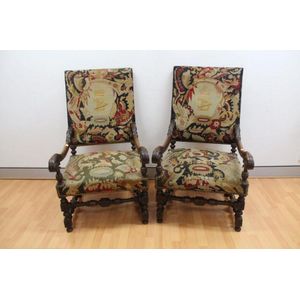Louis XIV Style Oak Fauteuils with Carved Details
You must be a subscriber, and be logged in to view price and dealer details.
Subscribe Now to view actual auction price for this item
When you subscribe, you have the option of setting the currency in which to display prices to $Au, $US, $NZ or Stg.
- Turning - Any part of a piece of furniture that has been turned and shaped with chisels on a lathe. Turned sections include legs, columns, feet, finials, pedestals, stretchers, spindles etc. There have been many varieties and fashions over the centuries: baluster, melon, barley-sugar, bobbin, cotton-reel, rope-twist, and so on. Split turning implies a turned section that has been cut in half lengthwise and applied to a cabinet front as a false decorative support.
- Louis Xiv - Louis XIV (1638 ? 1715), known as Louis the Great or the Sun King, ruled through Cardinal Mazarin as chief minister from 1643 to 1661 and as monarch of the House of Bourbon and King of France and Navarre from 1661 until his death in 1715. His reign of 72 years is one of the longest in French and European history.
- Stretcher - A horizontal rail which connects the legs of stools, chairs, tables and stands, to provide stabilisation of the legs. A stretcher table is any table with a stretcher base. The term is usually applied to substantial farmhouse tables, although many cabinetmaker's pieces, such as sofa tables, also have turned stretchers.
- Oak - Native to Europe and England, oak has been used for joinery, furniture and building since the beginning of the medieval civilisation. It is a pale yellow in colour when freshly cut and darkens with age to a mid brown colour.
Oak as a furniture timber was superceded by walnut in the 17th century, and in the 18th century by mahogany,
Semi-fossilised bog oak is black in colour, and is found in peat bogs where the trees have fallen and been preserved from decay by the bog. It is used for jewellery and small carved trinkets.
Pollard oak is taken from an oak that has been regularly pollarded, that is the upper branches have been removed at the top of the trunk, result that new branches would appear, and over time the top would become ball-like. . When harvested and sawn, the timber displays a continuous surface of knotty circles. The timber was scarce and expensive and was used in more expensive pieces of furniture in the Regency and Victorian periods.
This item has been included into following indexes:
-
chairs, singles / pairs / threes, style or period
- fauteuils (arm chairs) 240
- French 949
- Louis XIV 47
- Victorian, other styles 1,179
- chairs, singles / pairs / threes, timber - oak 488
Visually similar items

Pair of antique French Louis XIV highback armchairs, carved walnut leaf capped arms (2)

A fine pair of tapestry covered Louis XIII style carvers, the generous chairs of square back form with curvaceous arms with turned supports to square stuffover seats raised on turned and block legs with conforming 'H' form stretchers; superbly upholstered

A pair of Louis XV style semi-wingback bergeres, each with a floral upholstered back, above padded arms and a fitted seat, with foliate carved decoration

An elm upholstered armchair and footstool, circa 1850, of grand proportions with a high back and covered arms with extendable knop lopers, upholstered in William Morris inspired tapestry with button studs, upon turned legs with a conforming H-stretcher and
